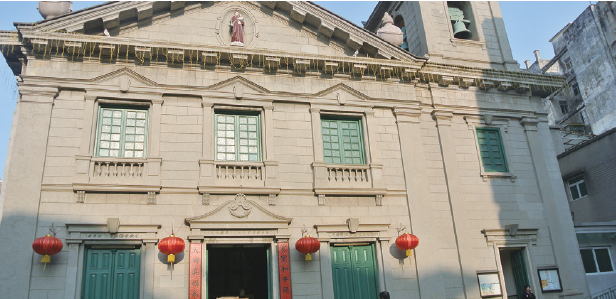Can you think of a place where it’s always good to be lost? In Macao, even though one ends up in an unknown or unplanned area at every corner of the street there is something to expect. The whole city is full of history, and at the same time, full of life. The Sookmyung Times (SMT) visited the Historic Center of Macao and looked into the city’s past and present.
Past: Harmony of East and West

“Exotic.” This is the first impression most people get when they walk into the Historic Center of Macao. SMT found it easy to notice that Macao differed from other Eastern and Western countries. Macao has embraced diverse cultures in its history. In the mid-16th century, Portuguese traders first started to settle in Macao. From then, it grew into a port city so the traders and people who settled in Macao brought with them their history and culture. The Portuguese came from Africa, India, and Arabic and Islamic countries. It was a gateway between the East and West, and this accumulation of diverse regional context formed the atmosphere of the city today. In fact, it is easy to see the unique scenes of East and West as one wanders the Historic Center. The streets are full of both temples and churches. For example, next to the Ruins of St. Paul’s Cathedral which is the remainder of a church destroyed by a fire in the past, there stands the Na Tcha Temple made to worship the child god of war, Na Tcha, in order to prevent plague. All of this is due to Macao’s multicultural identity and religious freedom in the past. The more SMT walked around the city, the more it became evident that Macao’s culture was neither pure Chinese nor Portuguese but
a combination of these and others.
Present: Alive Among Citizens

While SMT looked around the Historic Center, it became noticeable that most of the UNESCO World Heritage sites in Macao were still utilized as places for citizens. In many other countries, once a site is registered with UNESCO World Heritage, the nation’s government regulates resident entrance for more delicate care and preservation. However, in Macao, although every part of the city was a heritage artifact, they were not separated from the daily life of citizens. People still live in the city just as they had in the past. The churches are still used as churches, the markets as markets. Carla Figueiredo, an architect at the Cultural Affairs Bureau Macao, commented, “Our main objective is to preserve the heritage places by keeping their functions alive. We don’t want to evacuate the people living inside the buildings.” During the trip, SMT visited the site of a living heritage that operates harmoniously with people’s everyday life. We visited the St. Anthony Church, one of the oldest churches in Macao. It was easy to realize that we were the only tourists there as most other people were ordinary citizens praying. Churches in Macao are still utilized as places to hold Catholic mass. As such, the places of heritage were so full of life. It felt as if we were standing between the past and present of Macao.
Bridge: Connecting the Past with the Present

The Cultural Affairs Bureau Macao acts as a bridge to help citizens use or incorporate the historic places of heritage in daily life. The Sookmyung Times (SMT) visited the Cultural Heritage Department (CHD) to learn of its work and duties.

SMT Since citizens inhabit many of Macao’s historic heritage, conflicts might occur between the government and the people living there. How do you deal with these problems?
CHD We always place importance on communication with the local community. We try to explain the situation including technical parts in talks. The moment they properly understand what the government is doing, more support they give. So before and after projects, we communicate with the public and respond to citizen concerns. The more people talk, the more they are involved, and the more they care about the heritage structures.
SMT Due to the effort as you just mentioned, Macao citizens seem proud of their heritage. Is there other effort that the government has been doing to enhance this kind of citizenship pride?
CHD Well, we hold lots of exhibitions all year around. Also, we educate school teachers about the places of heritage, and they convey the history to students. Moreover, we hold a program with young heritage ambassadors. Youth aged 18 to 24 are selected, trained, and then sent abroad to exchange diverse cultures. Later, they share their knowledge about the heritage places with family, friends, and the public.
Getting Closer to Each Other
Macao has managed its places of heritage so well that no accidents have occurred that could pose a threat to structures and that it has gained pride from its citizens. In the case of South Korea, insufficient administration of its places of heritage has been a hot potato. For instance, No. 1 national treasure of Korea, Sungnyemun, was burned down due to careless monitoring and security. The restoring work of Sungnyemun has been criticized as being of poor quality. Why are there so many accidents and controversies? Indeed, it’s inappropriate to call for the same management quality as Macao because Macao is a small city and has financial advantage with its 5% tax from casinos to arrange social and cultural activities. However, during SMT’s trip, there were parts that could be learnt from Macao. Its government knew that the more it communicated and exchanged thoughts, the more the public and government understood each other’s stance. It is tolerance and consideration that is needed between the government and its citizens.
* Special thanks to the Architects of the Cultural Heritage Department at the Cultural Affairs Bureau Macao, Carla Figueiredo and Deland Leong, for the interview.


